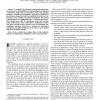Free Online Productivity Tools
i2Speak
i2Symbol
i2OCR
iTex2Img
iWeb2Print
iWeb2Shot
i2Type
iPdf2Split
iPdf2Merge
i2Bopomofo
i2Arabic
i2Style
i2Image
i2PDF
iLatex2Rtf
Sci2ools
TVLSI
2010
2010
Asynchronous Data-Driven Circuit Synthesis
A method is described for synthesizing asynchronous circuits based on the Handshake Circuit paradigm but employing a data-driven, rather than a control-driven, style. This approach attempts to combine the performance advantages of data-driven asynchronous design styles with the handshake circuit style of construction used in existing syntax-directed synthesis. The method is demonstrated on a significant design--a 32-bit microprocessor. This example shows that the data-driven circuit style provides better performance than control-driven synthesized circuits. This paper extends previous reported work by illustrating how conditional execution, oft-cited as a problem for data-driven descriptions, is handled within the system, and by a more detailed analysis of the design example.
Artificial Intelligence | Circuit Style | Data-driven Asynchronous Design | Handshake Circuit | TVLSI 2010 |
| Added | 22 May 2011 |
| Updated | 22 May 2011 |
| Type | Journal |
| Year | 2010 |
| Where | TVLSI |
| Authors | Sam Taylor, Doug A. Edwards, Luis A. Plana, Luis A. Tarazona |
Comments (0)

